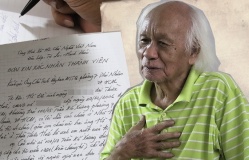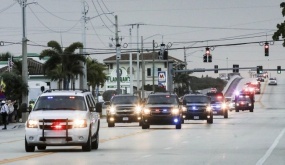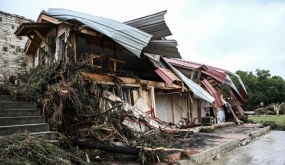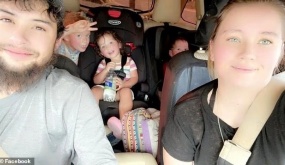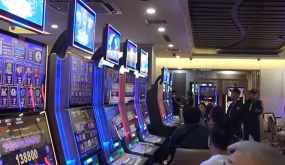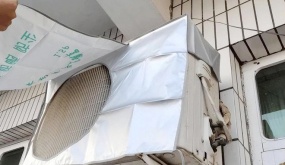Autism could be diagnosed with a hearing test at birth, study says
The technique by Lake Erie College of Osteopathic Medicine in Pennsylvania measures pressure changes in the middle ear in response to sounds.
20:00 08/01/2019
Children with autism could be diagnosed at birth with a simple hearing test, according to new research.
It would enable treatments to begin years before symptoms develop - when they are more likely to work.
The technique measures pressure changes in the middle ear in response to sounds - assessing sensitivity and response times to a wide range of frequencies.
Known as acoustic, or 'stapedial', reflex testing it's non-invasive - so can be used on infants without endangering their health.

Some of the earliest and most consistent signs involve hearing but most tests rely on speech - making them ineffective in the very young
There is a strong link between auditory dysfunction and autism suggesting newborns with hearing issues could be monitored for the neuro-developmental disorder.
Professor of anatomy Randy Kulesza Jr at Lake Erie College of Osteopathic Medicine in Pennsylvania, hopes it will lead to a screening program for all kids.
He said: 'Especially early in life the brain is very plastic - meaning the right early interventions can literally train out those deficits.
'The person might not be perfectly neuro-typical - but such interventions can improve function.'
Children with ASD (autism spectrum disorder) have problems with communicating, social interaction and are prone to repetitive behaviours.
But most cases are not confirmed until after the age of four meaning corrective therapies are started later - delaying their potential impact.
Some of the earliest and most consistent signs involve hearing but most tests rely on speech - making them ineffective in the very young.
The acoustic reflex is an involuntary muscle contraction in the ear when we speak - or hear loud noises.
Muscles pull tightly within the 'middle ear' to protect the delicate machinery of the inner ear from being damaged.
It's mostly used against deeper, low-frequency sounds - such as a heavy object hitting with the floor.
Dr Kulesza said: 'We know the vast majority of people with autism have some type of hearing problem connected to abnormalities in the brain.
'That means these issues will be present and detectable at birth.'
Uncovering them would also improve outcomes for all children - because the finding would trigger early interventions.
The finding published in the Journal of the American Osteopathic Association said was based on a review of brain scan studies and post-mortems of autism patients.
It found early detection would benefit all those with deafness - whether they had autism or not.
Most autism patients have hearing problems - but not everyone with the latter has the former, said Dr Kulesza.
Hearing is also critical to speech-language development which - in turn - also affects social-emotional development.
By optimising auditory function the person's quality of life can be profoundly better, he said.
Currently all newborns have their ears examined. But this merely assesses whether the child can hear on a pass or fail basis.
Prof Kulesza said acoustic reflex testing provides much more information about the types of dysfunction that may be present.
He explained: 'Often people with autism suffer from hypersensitivity - meaning even relatively quiet sounds can feel like overwhelming noise.
'If parents and physicians understand that from the start they can work to acclimate the child's sensitivity and make his or her experience of the world much less intense and frightening.'
Prof Kulesza said autism spectrum disorders - the umbrella term for a range of similar conditions including Asperger syndrome - and auditory dysfunction are clearly linked.
But more research is needed to understand how best to employ interventions for those who have the hearing issues.
Charities estimate around 700,000 people who are on the autism spectrum in the UK - about one in every 100 people.
In the US it's as high as 3.5 million. It's four times more common in boys.
There's no 'cure' for but speech and language therapy, occupational therapy and educational support are available to help children and parents.
One serious concern Prof Kulesza shares is causing unnecessary stress to parents.
He emphasises acoustic reflex testing should not be presented as a diagnostic tool.
Instead parents should understand testing positive for auditory dysfunction allows for tailored early intervention that will maximise their child's potential.
Dr Kulesza said: 'The literature provides an abundance of data supporting both abnormal structure and function in the auditory brainstem in persons with ASD.
'Furthermore, there is evidence from a number of functional studies for irregularities in brainstem processing of sound in ASD.
'Both functional and anatomical investigations indicate auditory issues are present at birth.
'Current screening for ASD typically fails to identify ASD until social or verbal abnormalities are present.
'Auditory function could be used to raise suspicion or identify children at high risk of ASD manifesting later in life.
'The goal of early detection and diagnosis is early intervention to improve the quality of life of persons with ASD.
'Early intervention for children with ASD focusing on eye contact, gesturing and vocalisations can substantially improve the child's language and social interactions.
'There is also evidence auditory integration training normalises brain stem responses in children with ASD and even improves behaviours.
'Additional research in these areas will result in better integration and outcomes for children with ASD.'

Florida: Cướp nhầm nhà vô địch đấm bốc, tên cướp trẻ tuổi bị đánh gãy xương sườn
Một vụ việc đầy bi hài đã xảy ra tại Florida, khi một tên cướp thiếu niên khoảng 20 tuổi bị gãy xương sườn do chọn nhầm “nạn nhân”.








